5 Easy Fine Motor Math Activities with Hole-Punched Leaves!
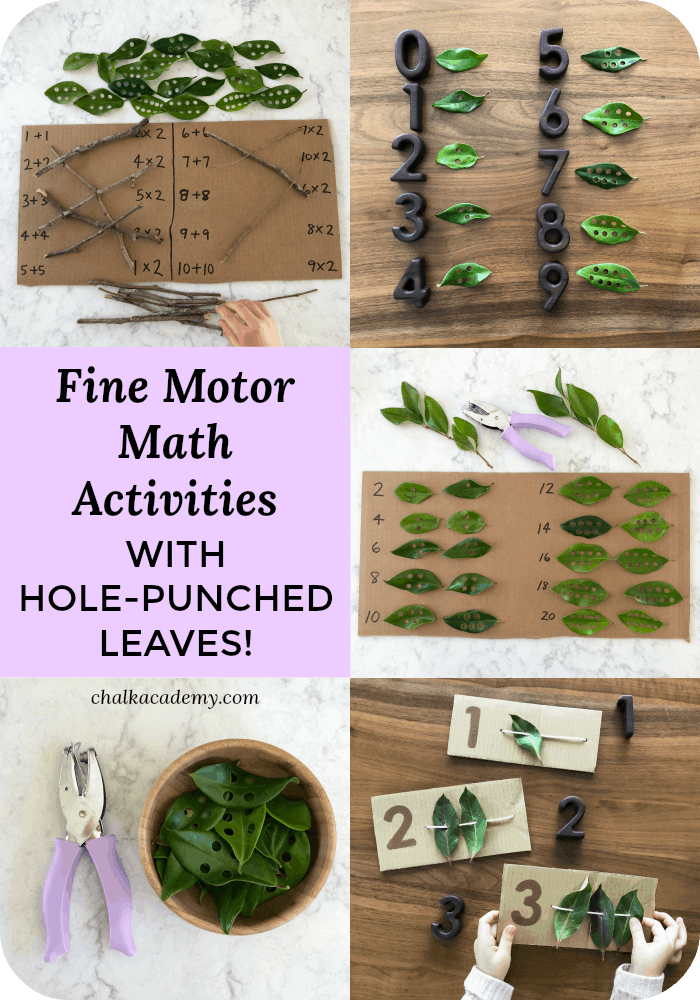
These 5 Fine Motor Math Activities with Hole-Punched Leaves are easy to set up with things you have at at home while strengthening fine motor skills!
Chalk Academy is reader-supported. Some of the links are affiliate links. When you buy something through an affiliate link, we may earn a very small commission at no additional cost to you. More details here.
Connecting with nature while learning math and language
Since most of the world is moving in a digital direction, our kids can miss out on easy and free learning opportunities from nature. To quote the renowned educator, Dr Maria Montessori, ““How often is the soul of man – especially in childhood – deprived because he is not allowed to come in contact with nature?”
While doing each activity with your kids, quietly observe their self-discovery of the materials. Then talk to them using rich, descriptive language about the different nature and math elements of the activity.
Since my kids are learning Chinese as a minority language, hands-on activities are a great way to practice new Chinese vocabulary in a new and exciting context.
You’ll see that math apps are completely unnecessary and not as multifaceted as hands-on activities!
Important counting vocabulary in Chinese, English, and Pinyin:
Since my children are bilingual in Chinese and English, they are learning to count and compute in both languages. The Pinyin has been added here for other families learning Chinese.
- 一,二,三,四,五,六,七,八, 九, 十 (yī, èr, sān, sì, wǔ, liù, qī, bā, jiǔ, shí / 1, 2, 3, 4, 5, 6, 7, 8, 9, 10)
- 零 (líng / 0)
- 数 (shù / count)
- 加法 (jiāfǎ / addition)
- 加在一起 (jiā zài yīqǐ / add together)
- 减法 / 減法 (jiǎnfǎ / subtraction)
- 乘法 (chéngfǎ / multiplication)
- 除法 (chúfǎ / division)
- 打孔 (dǎ kǒng / perforate, punch a hole)
- 打孔器 (dǎ kǒng qì / hole puncher)
- 叶子/葉子 (yèzi / leaf)
- 树枝 /樹枝 (shùzhī / branch)
Explore this: How I Taught My Child 1000 Chinese Characters as a Non-Fluent Speaker

5 WAYS TO PLAY AND LEARN WITH HOLE-PUNCHED LEAVES!
What you need:
- Leaves – the kids had fun collecting them from our yard!
- Hole punches – Our Fiskars 1/4 inch circle hand punch was easy for my 4-year-old to use independently. Remember to clear the catcher after using so that leaves are not left in there! You can also save the circles to use as nature confetti!
- Branches – we borrowed some branches from our Rainstick Sensory Bottles!
- Recycled cardboard
- Number blocks! We love these natural wood number blocks and this numbers puzzle.
- String
1. Nature leaf abacus
You can make a simple leaf abacus with leaves, string and cardboard! My 2-year-old son can rote count, but he does not understand what numbers represent. Therefore, I created this abacus to help him distinguish the difference between 1, 2, and 3. He seems to comprehend 1 but loses track after 2!

When kids are learning how to count for the first time, counting out loud with various objects is important for them to learn what the numbers mean. The actual number figure is not that important initially.
Once they understand quantity, then you can encourage the connection with the numeral. However, since my son likes his number puzzle, I added a number match element to the card by tracing his number blocks.
Having all leaves on the same board was overwhelming for my son. Since he doesn’t know that items in a row are grouped together, I separated each row to create 3 individual cards. Then, I secured the strings with knots at the back of the cardboard.

To make counting fun and relevant, we pretended the leaves were little beds for his Schleich toy animals! This is also a way to teach 1:1 correspondence at a level that is meaningful to a young toddler.
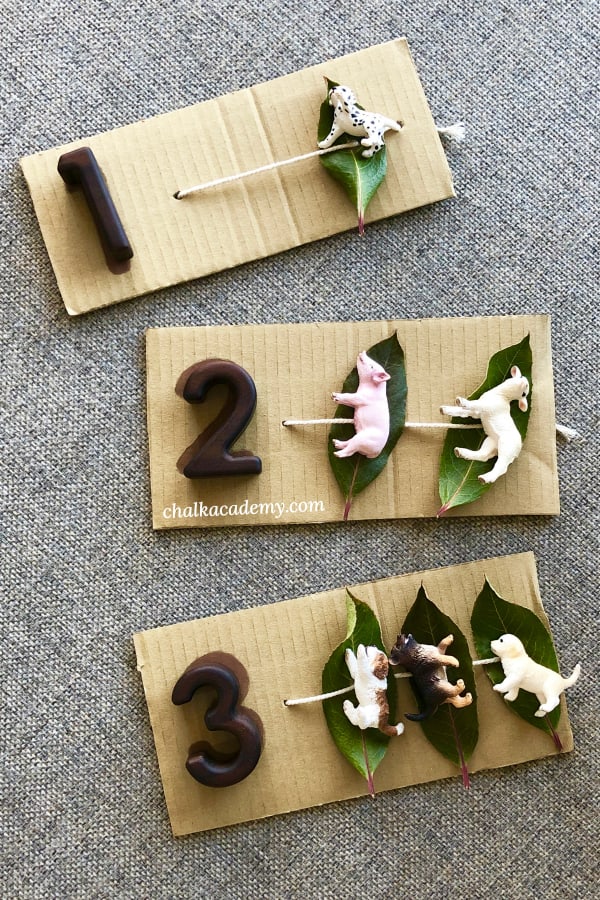
And here is how I set it up on our children’s learning shelf! As my sons grows and understands more, my hope is to make more of these for him!

2. Simple number and quantity matching with hole-punched leaves
For the next few activities, we punched 2 sets of leaves with 0-10 holes. Kids can punch the holes themselves for fine motor strength improvement.
However, if adults are preparing the activity, you may want to try to align the holes so that it is easier for kids to count and recognize even and odd numbers.
Try these hole-punching numeracy ideas depending on your child’s developmental level:
- Using 2 sets of hole-punched leaves, match the leaves with matching numbers of holes.
- Match number of leaf holes to number block. Feel the number block and the holes in the leaves to use the tactile sense to remember the one-to-one correspondence. If you don’t have number blocks, you can write the numbers on cardboard with glitter glue or puffy paint for texture!
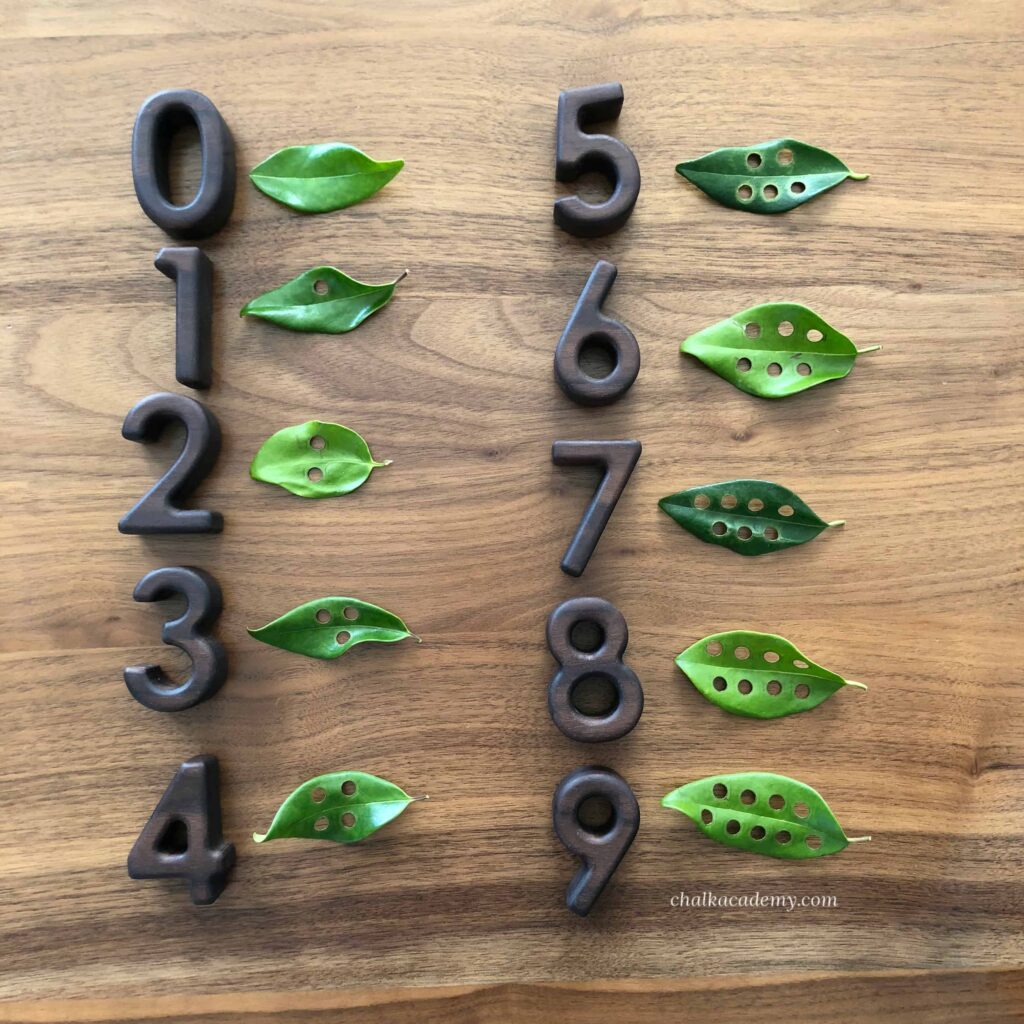
3. Simple Addition and Multiplication with Hole-Punched Leaves!
For older toddlers, kindergartners, and lower elementary school kids, you can use the hole-punched leaves to teach:
- Even numbers
- Addition
- Multiples of 2
- Pairs
- Symmetry (if you are deliberate about punching the holes in mirror image patterns)
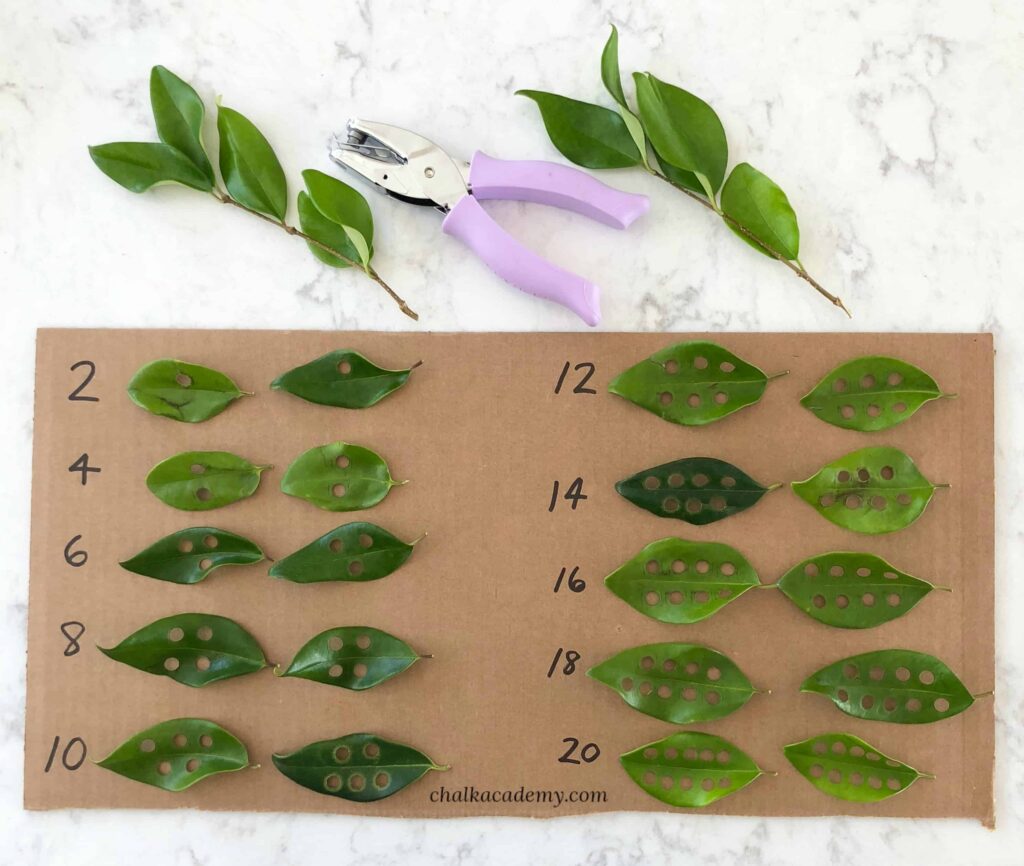
Related: Montessori Multiplication and Division Boards – Our Home Learning Experience
4. Fine Motor Math Matching Activity with Branches and Equations
This next fine motor math activity involves branches! In the next few photos, my 4-year-old daughter is matching addition and multiplication equations!
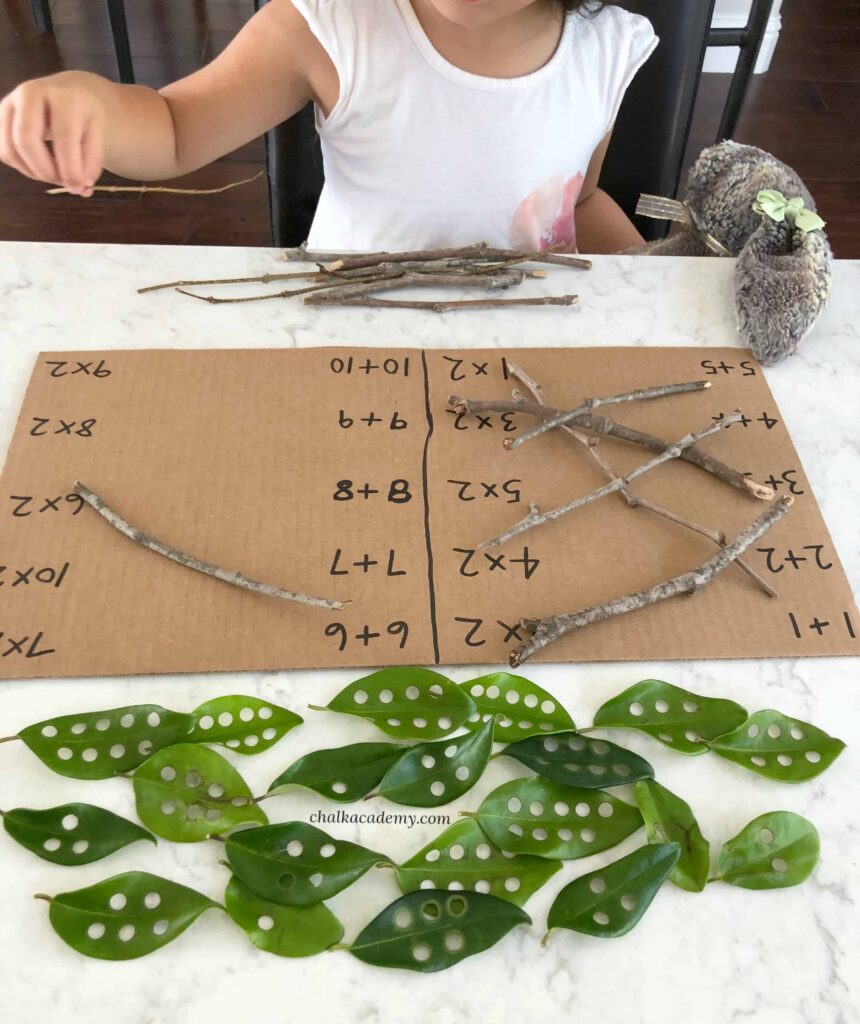
Since my daughter is just starting to learn multiplication, I set up the activity to show how multiplication is related to addition. However, if you have a younger child, you can have them match numbers only, or an addition equation to a sum.
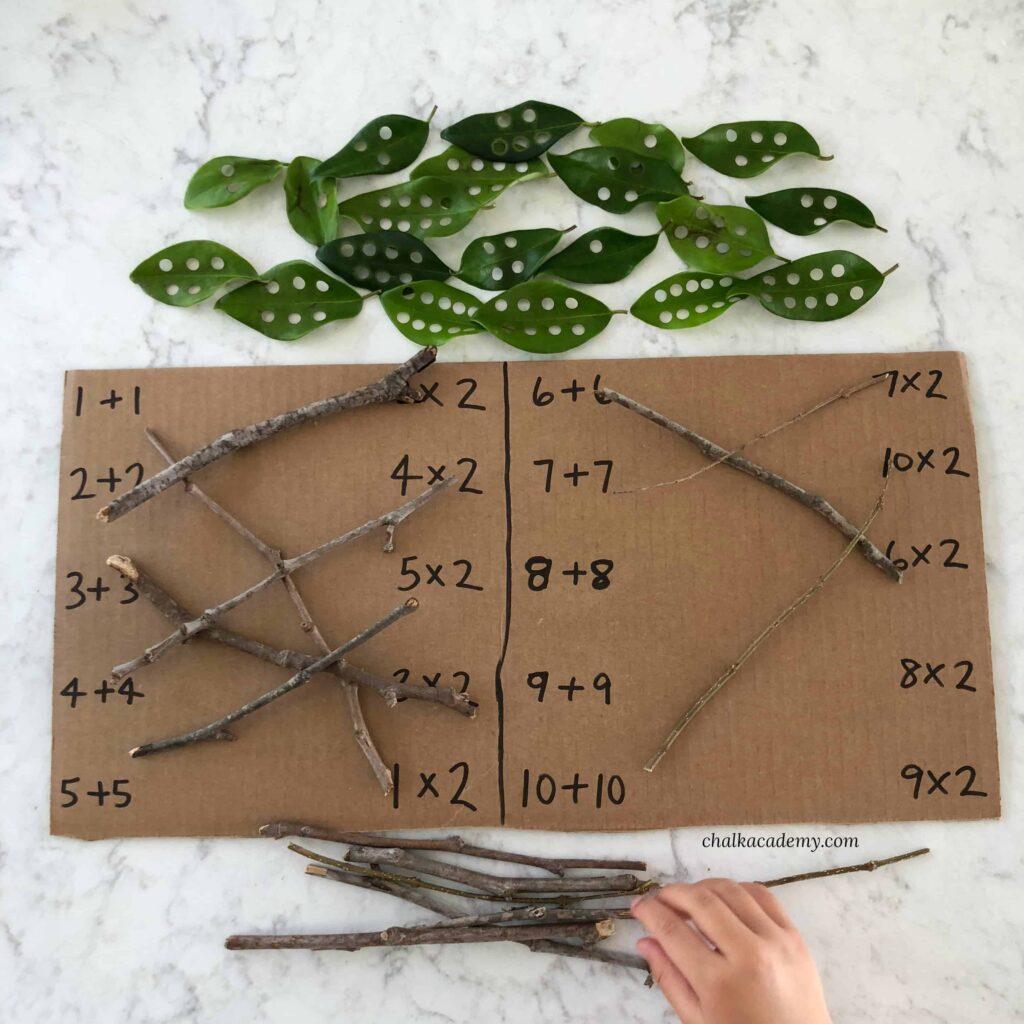
All done with this nature-inspired Fine Motor Math Activity with Hole-Punched leaves! And all of this math learning was completely free!
Yay for saving money and being environmentally conscious while learning!

5. Free play time!
I love seeing how the kids explore with nature activities on their own! My son had fun threading branches through the holes and as well as the tail of his Schleich toy kangaroo!
Free play is an incredibly important way for kids to discover object properties. For example, objects might be too big and small for the hole. They have to examine the shape of each hole (eg, circle) plus the delicate features of the leaf. Through touch, the sensory feedback will teach the child that the leaf will tear if he or she is not gentle.
For a few days, we also left the leaves in a small bowl so they could feel the daily textural changes as the leaves became dry!
Explore this: The Best Open-Ended Toys for Children
Have you tried any of these math lessons with leaves?
If you try Fine Motor Math with Hole-Punched Leaves, please let us know in the comments!
Math activities for children
Nature learning activities
To see all activities by topic, please bookmark our hands-on learning activities menu for reference for your planning convenience!
Honestly speaking this article is very helpful for students..very informative and useful article. i will share your blog in my groups.
Thanks a lot for sharing and keep posting.